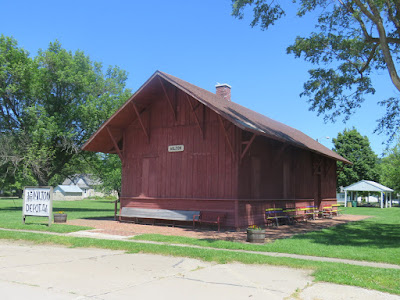Continuing
west toward our goal in Omaha, we stopped to take a couple of photos of
historic places in Bloomfield Iowa.
The
Davis County Courthouse in Bloomfield, Iowa, United States was built in 1877. This courthouse
is the second building to house court functions and county administration. The county’s first courthouse, built in 1844,
was a 24 foot by 40 foot log building. By
1851, the first building was unusable and a Methodist church functioned as a
courtroom until 1877.
Politics
ruled! It took 5 different proposals
before the voters would finally approve the funding for the present
courthouse! The cornerstone for this
magnificent Second Empire/Victorian “General Grant Gothic” structure was laid in
August of 1877. The final cost for the
building was $61,496.58.
The
cupola and the belfry are topped by a statue of the goddess of Justice. The four-sided clock was made by the Seth
Thomas Company and it still operates up in that clock tower.
Factoid:
· On August 27, 1924, Henry
"Dare-Devil" Roland, "The Human Fly," attempted to climb
the northwest corner of the courthouse. He fell to the ground from about 25
feet, breaking his hip. He was
hospitalized in Bloomfield for six weeks.
On June 28, 1932, Roland made a return trip to Bloomfield to remove the
blot from his record of successful climbs. This time, in just 11 minutes, he
was sitting astride the statue of Blind Justice.
Bloomfield’s
Town Square with the courthouse as the focal point is listed on the National
Register of Historic Places. It includes
55 commercial buildings all of which were built between the 1850s and the
1890s. Most of the buildings are of
brick construction with no early frame buildings on the square. I couldn’t determine what type of store
occupied the Latimers building but I did note that that name is still active
around town.
In the
photo above, all of the buildings were constructed in 1893. As it happened, the entire block that faces
Franklin Street burned to the ground early that year. They were immediately rebuilt. All around the square, many of the buildings
have retained their original windows, doors and overall appearance.
This is
the East Jefferson Street side of the town square. It certainly is colorful! The yellow building and several others were built
before 1870. According to the document
submitted to the Federal Government justifying the square as an historic place, the yellow building once served as a hatchery. The gray building to the right of it has played several roles in Bloomfield.
It has served as a tin shop, a newspaper office and both men's and women's
clothing stores.
It isn’t
shown in the photo but the building at 101 East Jefferson Street was originally
J.R. Shaeffer's Jewelry Store. Shaeffer's
son Walter went on to open his own jewelry store in Fort Madison Iowa and in
the back room of his store, he founded the Shaeffer Pen Company. That company, now owned by the A.T. Cross
Company still produces pens…although they’re now being produced in China.
Serious
efforts are underway to refurbish and enliven Bloomfield’s Town Square. In addition to facelifts and landscaping,
part of the project involved the construction of a number of apartments on the
second floors of the old buildings. To learn
more about this positive effort, just go to http://www.bloomfieldmainstreet.com/.
This
sad derelict of a building is the former Chicago, Burlington and Quincy Railroad
combination depot in Bloomfield. I was
unable to determine when it was built.
I did
find an article from 2004 which said that after much debate, the city decided
to take this old landmark and put it up for sale. It all came down to money. City budgets had been cut and the costs to
refurbish the depot couldn’t be justified.
It would have taken several
thousand dollars to make it useable. Up
to that point the old Railroad Depot was home to the Davis County Day Care and
Preschool. They were forced to close out
after state inspectors found lead-based paint that can be harmful to children.
Before
the building was to be officially put on the market, the city needed to hold a
public hearing for the community as well as have a resolution written and
passed on the issue. Either nothing has
been done or no one has come forward to purchase this depot in the last 12
years.
The
first rail service to Bloomfield was by the Fort Madison, West Point,
Keosauqua and Bloomfield Railroad. It
started operations in 1853 but it was only in business until 1857. Another company bought the railroad and
continued operations.
Factoids:
· Railroad growth peaked in Iowa with roughly
10,500 miles of track between 1911 and 1917.
By 2001, the state had lost about 6,595 miles of track, with 3,800 miles
of that loss occurring since 1975. Currently there are only 3,905 miles of active
trackage in the state.
· The naming of the Davis County Seat was
done by the county commissioners. The
commissioners all favored different names so the matter was settled by the luck
of the draw. The name Bloomfield was
pulled out of a hat. The other choices were Jefferson and Davis. Politics at its best!
Just
click on any of the photos to enlarge them…
Thanks
for stopping by for a visit!
Take
Care, Big Daddy Dave





































